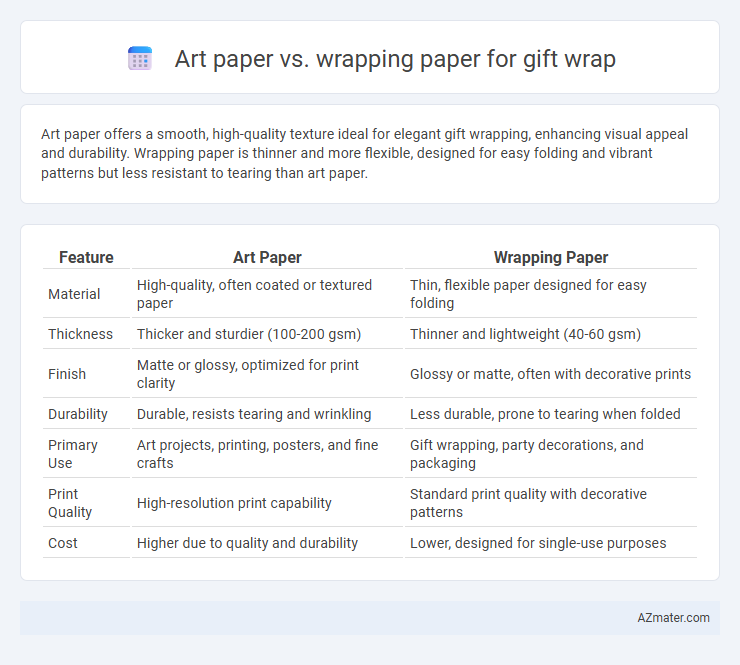Art paper offers a smooth, high-quality texture ideal for elegant gift wrapping, enhancing visual appeal and durability. Wrapping paper is thinner and more flexible, designed for easy folding and vibrant patterns but less resistant to tearing than art paper.
Table of Comparison
| Feature | Art Paper | Wrapping Paper |
|---|---|---|
| Material | High-quality, often coated or textured paper | Thin, flexible paper designed for easy folding |
| Thickness | Thicker and sturdier (100-200 gsm) | Thinner and lightweight (40-60 gsm) |
| Finish | Matte or glossy, optimized for print clarity | Glossy or matte, often with decorative prints |
| Durability | Durable, resists tearing and wrinkling | Less durable, prone to tearing when folded |
| Primary Use | Art projects, printing, posters, and fine crafts | Gift wrapping, party decorations, and packaging |
| Print Quality | High-resolution print capability | Standard print quality with decorative patterns |
| Cost | Higher due to quality and durability | Lower, designed for single-use purposes |
Introduction: Art Paper vs Wrapping Paper
Art paper offers a smooth, high-quality surface ideal for detailed designs and vibrant colors, making it perfect for artistic gift wrap presentations. Wrapping paper is typically thinner, more flexible, and designed for easy folding and secure wrapping with various patterns tailored for different occasions. Choosing between art paper and wrapping paper depends on the desired aesthetic effect and the durability required for the gift presentation.
Material Composition and Texture
Art paper typically features a thicker, high-quality cellulose fiber composition designed for durability and a smooth or textured finish ideal for fine art prints. Wrapping paper is usually made from lightweight, coated or uncoated wood pulp with a thinner texture that allows for easy folding and tearing. The difference in material composition directly affects the tactile experience and visual appeal when used for gift wrapping.
Visual Appeal and Design Options
Art paper offers a superior visual appeal for gift wrap due to its smooth texture, vibrant colors, and high-quality finishes that enhance the design's sharpness and detail. Wrapping paper tends to have simpler patterns and a thinner, less durable texture, which can limit the range of design options and reduce the overall aesthetic impact. Choosing art paper for gift wrapping elevates the presentation with more intricate, eye-catching designs and a polished, premium look.
Durability and Tear Resistance
Art paper offers superior durability and tear resistance compared to wrapping paper, making it ideal for gift wrap that requires a polished appearance and long-lasting protection. Its dense fibers and higher GSM (grams per square meter) contribute to increased strength, preventing easy ripping during handling. Wrapping paper, while visually appealing and lightweight, tends to be thinner and more prone to tearing, especially with intricate folds or rough handling.
Cost Comparison
Art paper typically costs more than wrapping paper due to its higher quality, durability, and superior printability, making it ideal for premium gift wrapping. Wrapping paper is generally more affordable, designed for temporary use, and widely available in bulk, offering a cost-effective solution for large-scale gift wrapping needs. Choosing between art paper and wrapping paper depends on the desired presentation quality and budget constraints.
Eco-Friendliness and Sustainability
Art paper typically offers greater eco-friendliness due to its often recycled content, biodegradability, and lack of glossy coatings, making it a sustainable choice for gift wrap. Wrapping paper frequently contains non-recyclable elements such as plastic films, metallic inks, or lamination, which hinder recycling and increase landfill waste. Choosing recyclable, uncoated art paper reduces environmental impact and promotes sustainable gift wrapping practices.
Ease of Wrapping and Workability
Art paper offers a smooth texture and firm structure, making it easier to crease sharp edges and create precise folds for gift wrapping. Wrapping paper is lightweight and more flexible, allowing for quick and efficient wrapping but may tear easily with intricate designs or heavy handling. For complex shapes or professional presentation, art paper provides superior workability, while wrapping paper suits casual, fast wrapping needs.
Printing Compatibility and Customization
Art paper offers superior printing compatibility with high-resolution inkjet and laser printers, allowing for vibrant colors and fine details ideal for customized gift wrap. Wrapping paper, typically coated and thinner, may cause ink smudging and less precise printing, limiting customization options. Choosing art paper enhances print quality and durability for personalized gift presentations.
Suitability for Various Gift Types
Art paper offers a smooth, durable surface ideal for wrapping delicate or high-value gifts such as jewelry or electronics, enhancing presentation with vibrant colors and fine details. Wrapping paper, often thinner and more flexible, suits a wide range of gifts including books, clothing, and toys, providing easy folding and secure wrapping. Selecting between art paper and wrapping paper depends on gift size, weight, and desired aesthetic, ensuring both protection and visual appeal.
Final Verdict: Choosing the Right Gift Wrap
Art paper offers a smooth texture and vibrant color saturation ideal for premium gift presentation, while wrapping paper provides affordability and a vast array of patterns for everyday use. Selecting the right gift wrap depends on balancing durability, aesthetic appeal, and occasion appropriateness, with art paper favored for luxury gifts and wrapping paper suited for casual, volume wrapping. Consider the recipient's preferences and the gift's value to ensure the wrapping enhances the overall gifting experience.

Infographic: Art paper vs Wrapping paper for Gift wrap
 azmater.com
azmater.com